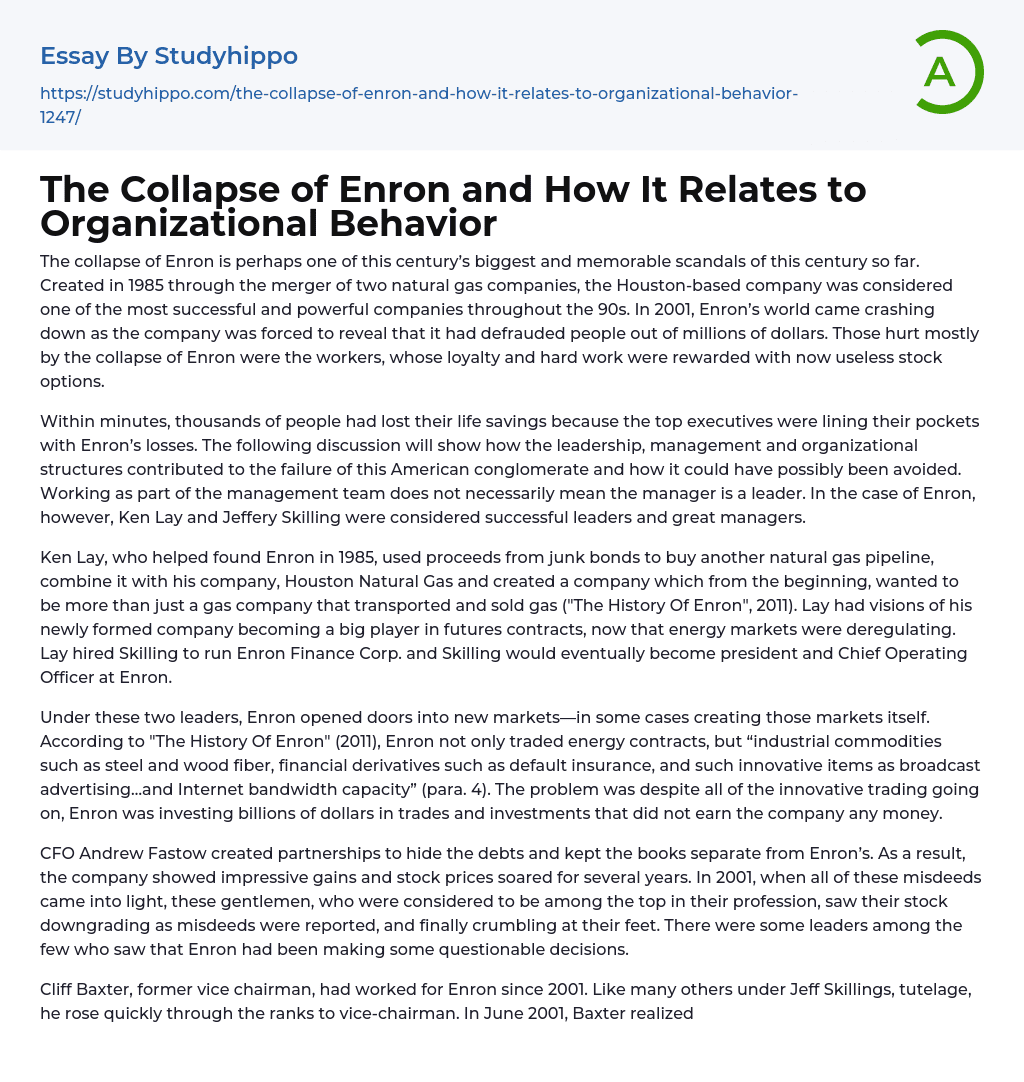

The Collapse of Enron and How It Relates to Organizational Behavior Essay Example
The Enron scandal in 2001 remains one of the most notable scandals of this century. Established in 1985 through the merger of two natural gas firms, Enron swiftly became renowned as a highly successful and influential company during the 90s. Yet, it was eventually revealed that Enron had engaged in deceptive practices, leading to significant financial losses. The principal casualties of this downfall were the employees, whose hard work and commitment went unnoticed, leaving them with worthless stock options.
Within a short amount of time, numerous individuals had lost their entire savings due to the fact that the top executives were enriching themselves with Enron's losses. The subsequent conversation will demonstrate how the failure of this American conglomerate was influenced by its leadership, management, and organizational structures, and explore potential measures that could have potentially prevented it
.... Being a member of the management team does not automatically indicate being a leader. Nonetheless, in the case of Enron, Ken Lay and Jeffery Skilling were regarded as accomplished leaders and exceptional managers.
Ken Lay, a co-founder of Enron in 1985, utilized funds obtained from junk bonds to purchase an additional natural gas pipeline. He merged this pipeline with his existing company, Houston Natural Gas, with the goal of creating a corporation that transcended the traditional role of merely transporting and selling gas. Lay's vision for the newly formed company involved establishing a prominent presence in futures contracts as the energy markets underwent deregulation. In order to achieve this vision, Lay enlisted Skilling to lead Enron Finance Corp., ultimately promoting him to the positions of president and Chief Operating Officer at Enron.
According to "The History Of Enron" (2011), Enron, under
the leadership of these two individuals, ventured into new markets and even played a role in creating some of these markets. Alongside energy contracts, Enron traded diverse commodities like steel and wood fiber, along with financial derivatives such as default insurance, and novel items like broadcast advertising and Internet bandwidth capacity. However, despite engaging in innovative trading activities, Enron faced a significant problem as it invested billions of dollars in trades and investments that yielded no financial gain for the company.
CFO Andrew Fastow established partnerships to conceal the company's debts and maintained separate financial records from Enron's. Consequently, the company demonstrated remarkable profits and experienced a significant increase in stock prices for a number of years. However, in 2001, when these unethical actions were exposed, these individuals, who were highly regarded in their field, witnessed a decline in their stock value due to the reported wrongdoings. Ultimately, their reputation and success disintegrated. A handful of leaders recognized that Enron had been engaging in questionable decision-making.
Cliff Baxter, former vice chairman, had joined Enron in 2001 and rapidly ascended to the role of vice-chairman under the guidance of Jeff Skillings. In June 2001, Baxter became aware of the unethical nature of Enron's operations and expressed his concerns to Skilling, cautioning that these financial practices would ultimately lead to the downfall of the company. Realizing that his chances of becoming president were now slim, instead of exposing Enron's wrongdoing publicly, Baxter chose to leave with his substantial wealth.
The text highlights the contrasting paths taken by two individuals involved in the Enron scandal. Baxter could have utilized the organization's lack of values and morals to propel himself as
a true leader within the company. However, he chose a different route and was accused of prematurely cashing in his options, resulting in his own desperate demise (Booth Thomas, Fonda, Pappalardo & Thotta, 2002).
On the other hand, the whistle-blower Sherron Watkins emerged as the real leader amidst the scandal. In an extensive email addressed to Ken Lay in August 2001, Watkins boldly revealed that Enron functioned as nothing more than a Ponzi scheme (Pellegrini, 2002).
She expressed her concerns to partners at Arthur Andersen, a auditing firm, stating "I am extremely worried that we will collapse due to a series of accounting scandals. My eight years of experience at Enron will have no value on my resume, and the business community will view our past achievements as nothing more than a sophisticated accounting fraud" (Pellegrini, 2002, para. 4). Even if both Baxter and Watkins had taken further action to expose the Enron executives, it is unlikely that any different outcome could have been expected.
The top management should have initiated the necessary change, prioritizing the employees and customers over themselves. References: Booth Thomas, K. , Fonda, D. , Pappalardo, J. ; Thotta, J. (2002, February). Enron takes a life. Time Magazine. Retrieved from http://www. time. com/time/magazine/article/0,9171,1001771-2,00,html Pellegrini, F. (2002, January). Person of the Week: Enron ‘Whistle Blower’ Sherron Watkins. Time Magazine. Retrieved from http://www. time. com/time/nation/article/0,8599,194927,00. html The history of Enron. (2011). Retrieved from http://www. npr. org/news/specials/enron/history. html
- Perseverance essays
- Expressive essays
- Character Traits essays
- Apology essays
- Compassion essays
- Adult essays
- Aggression essays
- Altruism essays
- Archetype essays
- Behavior essays
- Certainty essays
- Conformity essays
- Deception essays
- Human Behavior essays
- Human Sexuality essays
- Maturity essays
- Morality essays
- Obedience essays
- Procrastination essays
- Reinforcement essays
- Role Model essays
- Adidas essays
- Amazon essays
- Apple essays
- Bmw essays
- British Airways essays
- Burger King essays
- Coca-Cola essays
- Company essays
- Costco essays
- Dell essays
- Ebay essays
- Enron essays
- Facebook essays
- Ford Motor Company essays
- Gap essays
- General Motors essays
- Google essays
- Honda essays
- Ibm essays
- Ikea essays
- Intel essays
- Iphone essays
- Johnson and Johnson essays
- Kellogg essays
- Key essays
- Kfc essays
- Mcdonald's essays
- Microsoft essays
- Myspace essays



